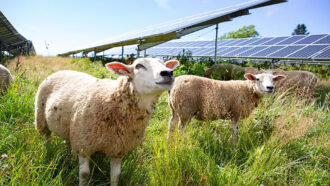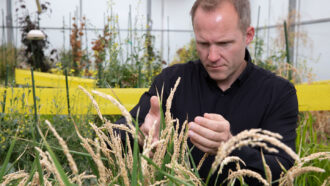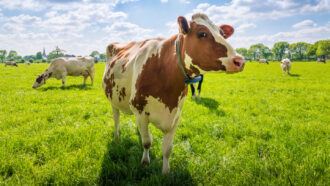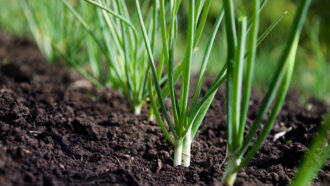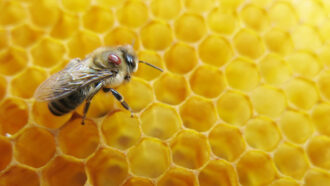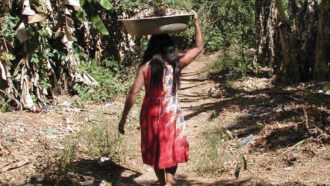‘Wildlife-free’ farms don’t make salads safer
Efforts to keep germs from veggies may harm wildlife without making food safer, a new study finds
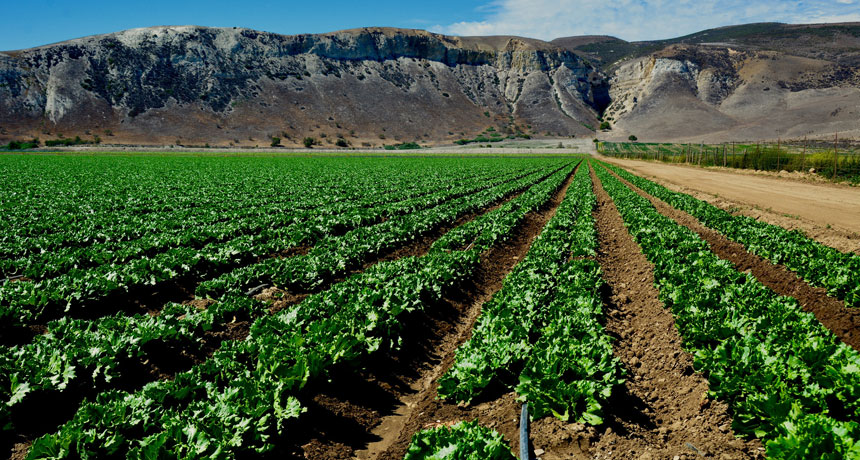
Areas surrounding fields of leafy greens, like this lettuce, have been cleared of habitat for wildlife. In some places, companies that buy and sell leafy greens require their suppliers to keep such animals from farm fields. The goal has been to keep animals from leaving behind disease-causing germs.
Harold Litwiler/Flickr (CC-BY 2.0)
Eating veggies is good for your health — as long as they are free of disease-causing germs. Some of those germs can come from birds, rabbits and other animals that wander in and near fields where crops are growing. Keeping animals out should therefore prevent major outbreaks of illness. Or that’s been the idea behind moves to limit wildlife’s access to crops. But a new study finds that fencing out animals and removing their habitat isn’t working. It doesn’t make salad greens less germy.
The findings, reported August 11 in Proceedings of the National Academy of Sciences, were striking. Removing wildlife habitat, such as brush, trees and shrubs, did not improve food safety. In fact, it seemed to increase levels of germs, not reduce them.
A major push to keep wildlife out of farms began in 2006. It followed an outbreak of E. coli bacteria that sickened more than 200 people and killed five. Raw spinach sold and eaten in 26 states had hosted the germs. Investigators eventually traced the bacteria to a farm in California. There, the same type, or strain, of E. coli was found in the soil, water and feces of both wild pigs and nearby cattle. The natural conclusion was that animal feces must be behind the spinach contamination.
E. coli bacteria occur naturally in the guts of animals, including people. Some strains of these germs can cause severe diarrhea. In really bad cases, they can trigger kidney failure and even death. One such strain had tainted spinach in the 2006 outbreak. And washing the greens hadn’t completely removed the germs before those greens were sold.
Under pressure from stores, customers and others, farmers began to remove wildlife from their fields. They put up fences to keep deer, pigs and other animals from getting near crops. Farmers cleared nearby areas of trees, shrubs and other non-crop plants, leaving behind bare ground. That was meant to remove habitat for wildlife.
Such changes worried conservation biologists. These are scientists who work to preserve ecosystems and species threatened or endangered with extinction. Those shrubs and other bits of nature surrounding fields can play a critical role in supporting wildlife. One big concern was for pollinators, such as bees. Many farm crops depend on such pollinators, which have been in decline. So making farms less friendly to them could risk making a growing pollinator shortage worse, biologists had argued.
Still, the farm changes were made to prevent illness. And if they worked, that might have made these anti-wildlife measures worthwhile.
Except they didn’t make the crops safer. That’s the conclusion of the new study by scientists at the University of California, Berkeley.
How they reached that conclusion
Ecologist Daniel Karp and his colleagues examined data collected at a large farming operation over seven years. During that time, the farmers collected a quarter of a million samples from their produce. Biologists tested each sample. They were looking for various strains of E. coli, as well as for Salmonella, another type of bacteria. Salmonella causes nearly one million U.S. cases of food poisoning each year.
Sampling for the germs began shortly after the 2006 E. coli outbreak. It continued as farmers evicted wildlife and their habitat from areas in and around crop fields. This gave Karp and his team the chance to see whether the changes affected levels of disease-causing germs, or pathogens. The scientists also sampled for these germs in nearby streams and wells. And they used aerial surveys to map and measure how much wildlife habitat bordered the farms.
They now report finding that removing wildlife habitat did not improve food safety. In fact, pathogen levels seemed to increase. This was particularly true in crop fields located near grazing livestock. That suggests rain water might have washed tainted cow dung onto nearby fields. Or it might merely indicate that removing habitat isn’t enough to keep wild animals from visiting farms.
Removing habitat from around farm fields does not prevent food-poisoning germs from tainting fresh produce, Karp concludes.
This is an important topic, says Trevor Suslow. He studies produce safety at the University of California, Davis. He was not involved with the study. The large increase in harmful E. coli found in this study contradicts what has been seen in previous research, he says. “But that doesn’t detract from the study’s overall conclusions,” he adds.
And he also agrees with one major take-home message from the new study: that “we need to balance food safety practices with environmental protection.”
Karp and his team now recommend adding more wildlife habitat to farms. For instance, they advise planting non-crop barriers between livestock and crops. These barrier plants, Karp explains, may clean and filter water before it passes into crop fields. Keeping livestock and wildlife away from shared waterways also could limit fecal germs from reaching crops.
Finally, the researchers suggest surrounding crops of salad veggies (those eaten raw) with others that require cooking. Animals may tend to stay near the edge of a field, the scientists note. This should keep their feces — and germs — from spreading beyond the outer crops. Any pathogens that do end up on these vegetables would later be killed during cooking. That, in turn, should protect leafy greens — and diners — from the germs shed by animals.
Power Words
(for more about Power Words, click here)
aerial Of or taking place in the air.
agriculture The growth of plants, animals or fungi for human needs, including food, fuel, chemicals and medicine.
bacterium (plural bacteria) A single-celled organism. These dwell nearly everywhere on Earth, from the bottom of the sea to inside animals.
biodiversity (short for biological diversity) The number and variety of species found within a localized geographic region.
biology The study of living things. The scientists who study them are known as biologists.
conservation The act of preserving or protecting something. The focus of this work can range from art objects to endangered species and other aspects of the natural environment.
conservation biologist A scientist who investigates strategies for helping preserve ecosystems and especially species that are in danger of extinction.
E. coli (short for Escherichia coli) A bacterium that researchers often use to study genetics. Some types of this microbe cause disease, but many other forms of it do not.
ecology A branch of biology that deals with the relations of organisms to one another and to their physical surroundings. A scientist who works in this field is called an ecologist.
ecosystem A group of interacting living organisms — including microorganisms, plants and animals — and their physical environment within a particular climate. Examples include tropical reefs, rainforests, alpine meadows and polar tundra.
endangered An adjective used to describe species at risk of going extinct.
environment The sum of all of the things that exist around some organism or the process and the condition those things create for that organism or process. Environment may refer to the weather and ecosystem in which some animal lives, or, perhaps, the temperature, humidity and placement of components in some electronics system or product.
extinction The permanent loss of a species, family or larger group of organisms.
feces (adj. fecal) A body’s solid waste, made up of undigested food, bacteria and water. The feces of larger animals are sometimes also called dung.
germ Any one-celled microorganism, such as a bacterium, fungal species or virus particle. Some germs cause disease. Others can promote the health of higher-order organisms, including birds and mammals. The health effects of most germs, however, remain unknown.
habitat The area or natural environment in which an animal or plant normally lives, such as a desert, coral reef or freshwater lake. A habitat can be home to thousands of different species.
kidney Each of a pair of organs in mammals that filters wastes from the blood and that then shed those wastes in urine.
livestock Animals raised for meat or dairy products, including cattle, sheep, goats, pigs, chickens and geese.
outbreak The sudden emergence of disease in a population of people or animals. The term may also be applied to the sudden emergence of devastating natural phenomena, such as earthquakes or tornadoes.
pathogen An organism that causes disease.
pollinator Something that carries pollen, a plant’s male reproductive cells, to the female parts of a flower, allowing fertilization. Many pollinators are insects such as bees.
Salmonella A bacterium that can cause diarrhea, vomiting, and fever. In the United States alone, various forms of this germ are responsible for some one million cases of food poisoning each year.
shrub A perennial plant that grows in a generally low, bushy form.
species A group of similar organisms capable of producing offspring that can survive and reproduce.
strain (in biology) Organisms that belong to the same species that share some small but definable characteristics. For example, biologists breed certain strains of mice that may have a particular susceptibility to disease. Certain bacteria or viruses may develop one or more mutations that turn them into a strain that is immune to the ordinarily lethal effect of one or more drugs. (in medicine) Stretching or tearing of muscle or tendons, which are the fibrous bands that connect muscle to bone. (in physics) The forces or stresses that seek to twist or otherwise deform a rigid or semi-rigid object.

